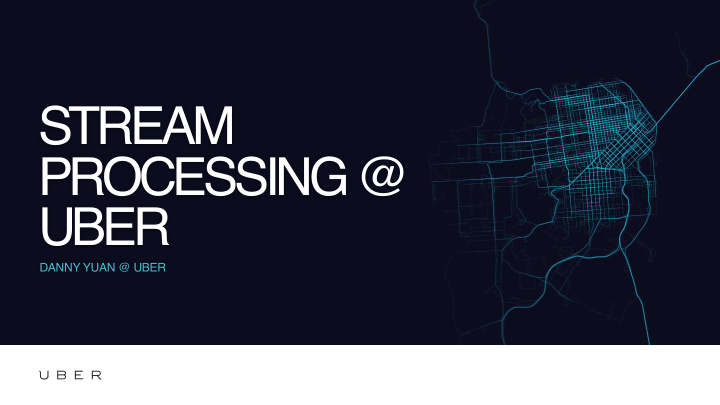



STREAM PROCESSING @ UBER DANNY YUAN @ UBER
What is Uber
Transportation at your fingertips
Stream Data Allows Us To Feel The Pulse Of Cities
Marketplace Health
What’s Going on Now
What’s Happened?
Status Tracking
A Little Background
Uber’s Platform Is a Distributed State Machine Rider States
Uber’s Platform Is a Distributed State Machine Rider States Driver States
Applications can’t do everything
Instead, Applications Emit Events
Events Should Be Available In Seconds
Events Should Rarely Get Lost
Events Should Be Cheap And Scalable
Where are the challenges?
Many Dimensions Dozens of fields per event
Granular Data
Granular Data
Granular Data Over 10,000 hexagons in the city
Granular Data 7 vehicle types
Granular Data 1440 minutes in a day
Granular Data 13 driver states
Granular Data 300 cities
Granular Data 1 day of data: 300 x 10,000 x 7 x 1440 x 13 = 393 billion possible combinations
Unknown Query Patterns Any combination of dimensions
Variety of Aggregations - Heatmap - T op N - Histogram - count(), avg(), sum(), percent(), geo
Different Geo Aggregation
Large Data Volume • Hundreds of thousands of events per second, or billions of events per day • At least dozens of fields in each event
Tight Schedule
Key: Generalization
Data Type • Dimensional T emporal Spatial Data Dimension Value state driver_arrived vehicle type uber X timestamp 13244323342 lattitude 12.23 longitude 30.00
Data Query • OLAP on single-table temporal-spatial data SELECT ¡<agg ¡functions>, ¡<dimensions> ¡ FROM ¡<data_source> WHERE ¡<boolean ¡filter> GROUP ¡BY ¡<dimensions> HAVING ¡<boolean ¡filter> ORDER ¡BY ¡<sorting ¡criterial> LIMIT ¡<n> DO ¡<post ¡aggregation>
Finding the Right Storage System
Minimum Requirements • OLAP with geospatial and time series support • Support large amount of data • Sub-second response time • Query of raw data
It can’t be a KV store
Challenges to KV Store Pre-computing all keys is O(2 n ) ¡ for both space and time
It can’t be a relational database
Challenges to Relational DB • Managing multiple indices is painful • Scanning is not fast enough
A System That Supports • Fast scan • Arbitrary boolean queries • Raw data • Wide range of aggregations
Elasticsearch
Highly Efficient Inverted-Index For Boolean Query
Built-in Distributed Query
Fast Scan with Flexible Aggregations
Storage
Are We Done?
Transformation e.g. (Lat, Long) -> (zipcode, hexagon)
Dynamic Pricing
Trend Prediction
Supply and Demand Distribution
Technically Speaking: Clustering & Pr(D, S, E)
New Use Cases —> New Requirements
Pre-aggregation
Joining Multiple Streams
Sessionization
Multi-Staged Processing
State Management
Apache Samza
Why Apache Samza?
DAG on Kafka
Excellent Integration with Kafka
Excellent Integration with Kafka
Built-in Checkpointing
Built-in State Management
Processing Storage
What If Storage Is Down?
What If Processing Takes Long?
Processing Storage
Are We Done?
Post Processing
Results Transformation and Smoothing
Scale of Post Processing 10,000 hexagons in a city
Scale of Post Processing 331 neighboring hexagons to look at
Scale of Post Processing 331 x 10,000 = 3.1 Million Hexagons to Process for a Single Query
Scale of Post Processing 99%-ile Processing Time: 70ms
Post Processing • Each processor is a pure function • Processors can be composed by combinators
Post Processing • Highly parallelized execution • Pipelining
Post Processing • Each processor is a pure function • Processors can be composed by combinators • Highly parallelized execution
Practical Considerations
Data Discovery
Elasticsearch Query Can Be Complex
/driverAcceptanceRate? ¡ geo_dist(10, ¡[37, ¡22])& ¡ time_range(2015-‑02-‑04,2015-‑03-‑06)& ¡ aggregate(timeseries(7d))& ¡ eq(msg.driverId,1) ¡
Elasticsearch Query Can Be Optimized • Pipelining • Validation • Throttling
Time in seconds
Elasticsearch Can Be Replaced
Processing Storage Query
There’s one more thing
There are always patterns in streams
There is always need for quick exploration
How many drivers cancel a request 10 times in a row within a 5-minute window?
Which riders request a pickup from 100 miles apart within a half hour window?
Recommend
More recommend